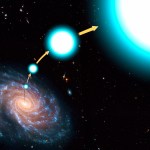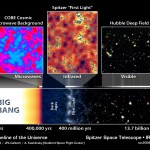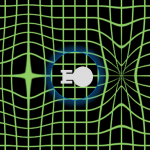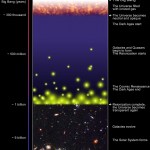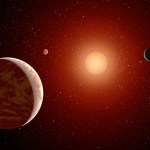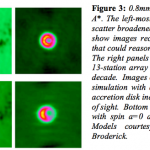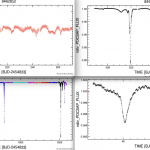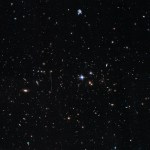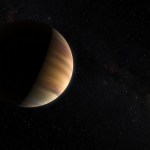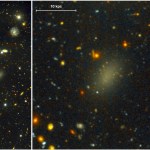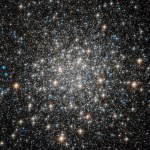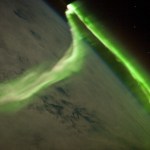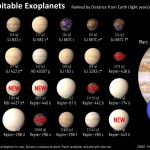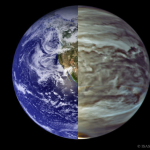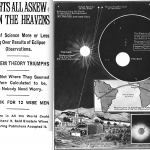
“Mapping out the elements in a star is like reading its DNA. We’re using those DNA readings to decode the history of the Milky Way from the stars that we can observe today.” -Steven Majewski
Most of the stars in our Milky Way have long lives ahead of them, with dozens or even hundreds of orbits around the entire galaxy to come over their lifetimes. With hundreds of billions of stars involved in this cosmic dance, it stands to reason that on occasion, another nearby star will either gravitationally or cataclysmically (e.g., from a supernova) kick such a star to incredible velocities, perhaps…
“When you see how fragile and delicate life can be, all else fades into the background.” –Jenna Morasca
The hot Big Bang — proposed seventy years ago — is a tremendous success story. Predicated on the assumption that the Universe was hotter, denser, more uniform and expanding faster in the past, it’s allowed us to predict the rate of cosmic expansion over distance and time, the primeval abundances of the light elements, the formation and evolution of large-scale-structure, and the existence and properties of the cosmic microwave background: the leftover photon glow from the Big Bang.
An…
"We are what we are, and we're doing the best we can. It is not for you to set the standards by which we should be judged." -Captain Picard, Star Trek: The Next Generation
Fifty years ago, on September 8, 1966, the first episode of the original Star Trek premiered. It introduced a vision of humanity’s future that included the ability to travel interstellar distances and investigate new, never-before-seen worlds at speeds far exceeding the speed of light. The technological advance that enabled it all? Warp drive, with the power to bend the fabric of space so severely that light years…
"Now the world has gone to bed, Darkness won't engulf my head, I can see by infrared, How I hate the night." -Douglas Adams
The Hubble Space Telescope is an amazing piece of equipment, and has seen more distant stars and galaxies than any telescope before or since. Earlier this year, it broke its own cosmic distance record by discovering a galaxy at a redshift of 11, back when the Universe was just 400 million years old. Yet the first stars should go back even farther, and Hubble will never see them.
The reionization and star-formation history of our Universe. Image credit: NASA / S.G.…
"I have lost tolerance for things without meaning. There is no time for them. Does that make sense?" -Sara Seager
The discovery of a potentially habitable planet around the nearest star to our own -- Proxima Centauri -- has brought up the tantalizing possibility that this might be closest Earth-like world ever found. But it’s important to realize that as much as we’d love to find a world humans could inhabit and colonize beyond our Solar System, there’s a big difference between calling something “Earth-like” and having it actually be like Earth.
An artist’s rendition of Proxima Centauri…
“Never look down to test the ground before taking your next step; only he who keeps his eye fixed on the far horizon will find the right road.” -Dag Hammarskjold
A black hole is a region of space that’s got so much mass in such a small volume that the escape velocity within a specific region is greater than the speed of light. We call this barrier from which light cannot escape the event horizon, and the sole arbiter of an event horizon’s size is the black hole’s mass. Since they come in a variety of sizes and a variety of distances from us, there’s a wide range of the apparent size of the…
"We meet aliens every day who have something to give us. They come in the form of people with different opinions." -William Shatner
It’s been another big week here at Starts With A Bang, with stories covering the Universe near and far. Although the biggest announcements seemed to shatter our picture of how things are, this week was all about keeping it in perspective. There are lots of ideas -- good and bad -- floating around, but in the end, data and experiments will be the ultimate arbiter. Here’s what we've covered over the past week:
How do we know the Universe is 13.…
"What, I sometimes wonder, would it be like if I lived in a country where winter is a matter of a few chilly days and a few weeks' rain; where the sun is never far away, and the flowers bloom all year long?" -Anna Neagle
At some point in the future, the Sun, the giver and sustainer of nearly life on Earth as we know it, will run out of fuel. Powered by nuclear fusion, it turns hydrogen into helium, producing energy in the process. Yet the Sun has a finite mass, a finite rate-of-fusion, and someday will run out of hydrogen. When it does, bright as it may be today, it will cease to someday…
"All of the books in the world contain no more information than is broadcast as video in a single large American city in a single year. Not all bits have equal value." -Carl Sagan
For every action, there’s an equal and opposite reaction. While Newton may not be the final word in mechanics anymore since the development of relativity and quantum physics, this law -- better known as the conservation of momentum -- has held up from the 17th century through the 21st in every interaction ever observed. Unless, that is, the EMdrive is everything it claims to be.
The surface magnetic field of an…
"A careful analysis of the process of observation in atomic physics has shown that the subatomic particles have no meaning as isolated entities, but can only be understood as interconnections between the preparation of an experiment and the subsequent measurement." -Fritjof Capra
For most living humans on the planet, the Standard Model and General Relativity, the theories that govern the four fundamental forces, have encompassed all of the known particles and their interactions for our entire lives. We know they can’t encompass all there is, but the search for the first particle beyond the…
"Otherwise we are trying to communicate with someone who doesn't exist with a system which doesn't work." -Philip K. Dick
When it comes to the now famous “Alien Megastructures” star, the observations didn’t add up. There were huge, irregular flux dips, but not a hint of infrared radiation that would indicate a circumstellar disk. Infrared radiation was the marker for a whole slew of indicators -- planetary collision debris, warped, thick disks, cometary swarms -- that could be the cause of such spectacular dips.
Image credit: Tabby Boyajian and her team of PlanetHunters, via http://…
“These galaxies are among the most massive galaxies in the universe and are believed to have rapidly formed their stars a long time ago. However, how these galaxies formed and why have they stopped forming new stars remain mysteries.” -Tao Wang, lead author on this new study
There was once a time early on in the Universe where there were no stars, no galaxies and no clusters of galaxies at all. While stars and galaxies form very early on, after only tens or hundreds of millions of years, it takes billions of years for the first clusters to form. Yet even if we were to look back into the…
"How vast those Orbs must be, and how inconsiderable this Earth, the Theatre upon which all our mighty Designs, all our Navigations, and all our Wars are transacted, is when compared to them. A very fit consideration, and matter of Reflection, for those Kings and Princes who sacrifice the Lives of so many People, only to flatter their Ambition in being Masters of some pitiful corner of this small Spot." -Christiaan Huygens
With the big news about Proxima b and Kepler’s haul of over 3,500 new planets since its launch, the idea that planets orbit stars other than our own is so mainstream that…
"Motions of the stars tell you how much matter there is. They don’t care what form the matter is, they just tell you that it’s there." -Pieter van Dokkum
Everything in the Universe was born with the same ratios of dark matter to normal matter: approximately 5-to-1. It shows up in everything from the cosmic microwave background to galaxy clustering to internal motions of spiral and elliptical galaxies, including the Milky Way.
From simulations and inferred maps, dark matter (blue) may form some clumps, but overall exists in a massive, diffuse halo around the luminous, disk-like part of…
"Because practical applications are so remote, many people assume we should not be interested. But this quest to understand the world is what defines us as human beings." -Yuri Milner
It’s been another big week here at Starts With A Bang, with stories covering the Universe near and far. First off, thanks to our generous Patreon supporters, we have a brand new podcast live today, on whether the Big Bang was really the beginning of the Universe.
It's 19 minutes of your life well spent, trust me. There are lots of amazing things that happened, including a candidate for "story of…
"The oldest and strongest emotion of mankind is fear, and the oldest and strongest kind of fear is fear of the unknown." -H.P. Lovecraft
There’s a unique relationship between everything that exists in the Universe today -- the stars and galaxies, the large-scale structure, the leftover glow from the Big Bang, the expansion rate, etc. -- and the amount of time that’s passed since it all began. When it comes to our Universe, there really was a day without a yesterday, but how do we know exactly how much time has passed between then and now?
The Universe's expansion rate is determined by the…
“Concentrate all your thoughts upon the work at hand. The sun’s rays do not burn until brought to a focus.” -Alexander Graham Bell
In 1859, the Sun surprisingly increased in brightness so significantly for just a brief while that it was noticeable from Earth during the day. Less than 24 hours later, aurorae were visible so brightly and so far south that people awoke in the middle of the night, thinking it was dawn. But in addition to the spectacular sights, there were also downsides: telegraph wires spontaneously caught on fire, causing significant amounts of damage.
The atmospheric effects…
"Our existence in this place, this microscopic corner of the cosmos, is fleeting. With utter disregard for our wants and needs, nature plays out its grand acts on scales of space and time that are truly hard to grasp. Perhaps all we can look to for real solace is our endless capacity to ask questions and seek answers about the place we find ourselves in." -Caleb Scharf
Now that we’ve learned the nearest star to our Sun, Proxima Centauri, has a rocky planet at the right distance for liquid water, it’s time to consider how we might learn the answers to our burning questions about it and all…
"To consider the Earth as the only populated world in infinite space is as absurd as to assert that in an entire field sown with millet, only one grain will grow." -Metrodorus of Chios
Later tonight, the European Southern Observatory is expected to make an announcement, and the smart money is on the discovery of an Earth-like planet orbiting Proxima Centauri, the nearest star to our Sun. As incredibly exciting as this news is, however, it’s important to keep in mind that “Earth-like,” to an astronomer, means something very different than what we think of as “actually like Earth.”
The…
“Astronomers are greatly disappointed when, having traveled halfway around the world to see an eclipse, clouds prevent a sight of it; and yet a sense of relief accompanies the disappointment.” -Simon Newcomb
Next year, on August 21st, 2017, millions of Americans will delight in the first total solar eclipse to go from coast-to-coast in 99 years. The path of totality will range from Oregon to South Carolina, giving more than two minutes of the Sun being blocked by the Moon’s shadow to all along its central path.
Image credit: Mir / RSA, 1999, of the Moon's shadow falling on Earth, during a…
